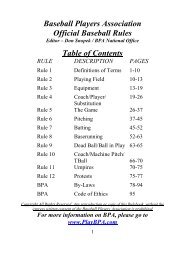baseball players association rule 1 definitions of terms
baseball players association rule 1 definitions of terms
baseball players association rule 1 definitions of terms
Create successful ePaper yourself
Turn your PDF publications into a flip-book with our unique Google optimized e-Paper software.
c.) In age divisions 13U and above, pitchers will be allowed to pitch twelve- (12) innings in two- (2)<br />
consecutive days.<br />
d.) Once a pitch is made to a batter by the starting or substitute pitcher, that pitcher will be<br />
considered to have pitched a complete inning.<br />
*PENALTY. If a pitcher has been found to have pitch more than the legal innings allowed will result in<br />
the immediate forfeiture <strong>of</strong> that game.<br />
RULE 7<br />
SECTION 1<br />
SECTION 2<br />
SECTION 3<br />
SECTION 4<br />
SECTION 5<br />
SECTION 6<br />
SECTION 7<br />
BATTING<br />
Each player <strong>of</strong> the <strong>of</strong>fensive team shall bat in the order that his name appears in his team’s batting order.<br />
*NOTE. At the start <strong>of</strong> the game, coaches shall have the option <strong>of</strong> using a continuous batting order <strong>of</strong> every<br />
player present at the start <strong>of</strong> the game in all levels <strong>of</strong> play for all teams 14 and under.<br />
The first batter in each inning after the first inning shall be the player whose name follows that <strong>of</strong> the last<br />
player who legally completed his time at bat in the preceding inning.<br />
The batter must take his position in the batter’s box within ten- (10) seconds after the umpire has called<br />
“Play Ball”.<br />
*PENALTY. The ball is dead. The umpire will call a strike on the batter, also issue a warning to the batter<br />
to take his position or risk being called out. If the batter refuses to take his position after the warning he<br />
will be called out. The warning will be given to a batter only one- (1) time per game. Any repeated<br />
violation during the game by that player will result in an out being called.<br />
The batter shall not leave his position in the batter’s box after the pitcher comes to a set position, or starts<br />
his windup.<br />
*PENALTY. If the pitcher pitches, the umpire shall call ball or strike as the case may be.<br />
a.) The batter leaves the batter’s box at the risk <strong>of</strong> having a strike delivered and called, unless he requests<br />
the umpire to call “Time” and the umpire grants the request <strong>of</strong> “Time”.<br />
b.) Once a batter has taken his position in the batter’s box, he shall not be permitted to step out <strong>of</strong> the<br />
batter’s box in order to use the resin or the pine tar rag, unless there is a delay in the game action or, in<br />
the judgment <strong>of</strong> the umpire, weather conditions warrant an exception.<br />
c.) Umpires may grant a hitter’s request for “Time” once he is in the batter’s box, but the umpire should<br />
eliminate hitters walking out the batter’s box without reason.<br />
d.) If after the pitcher starts his wind-up or comes to a “set position” with a runner on, and he does not go<br />
through with his pitch because the batter has stepped out <strong>of</strong> the box, it shall not be called a balk.<br />
The batter’s legal position shall be with both feet within the batter’s box.<br />
*NOTE. The lines defining the box are within the batter’s box.<br />
A batter has legally completed his time at bat when he is put out or becomes a runner.<br />
A batter is out when;<br />
a.) A fielder legally catches his fair or foul fly ball (other than a foul tip).<br />
b.) A third strike that is legally caught by the catcher.<br />
1.) Legally caught means in the catcher’s glove before the ball touches the ground.<br />
2.) It is not legal, if the ball lodges in his clothing or paraphernalia; or if it touches the umpire<br />
and is caught by the catcher on the rebound.<br />
3.) If a foul-tip first strikes the catcher’s glove and then goes on through and is caught by both<br />
hands against his body or protector, before the ball touches the ground, it is a strike, and if<br />
third strike, batter is out.<br />
4.) If smothered against his body or protector, it is a catch provided the ball struck the catcher’s<br />
glove or hand first.<br />
c.) The catcher does not catch a third strike when first base is occupied before two are out.<br />
d.) He bunts foul on the third strike.<br />
e.) An infield fly is declared.<br />
f.) He attempts to hit a third strike and the ball touches him.<br />
g.) His fair ball touches him before touching a fielder.<br />
h.) After hitting or bunting a fair ball, his bat hits the ball a second time in fair territory.<br />
*PENALTY. The ball is dead and no runners may advance.<br />
i.) If the batter-runner drops his bat and the ball rolls against the bat in fair territory and, in the umpire’s<br />
judgment, there was no intention to interfere with the course <strong>of</strong> the ball, the ball is alive and in play.<br />
22



